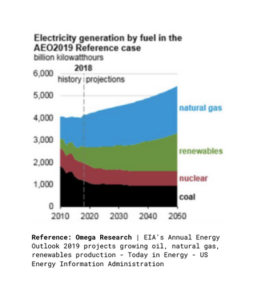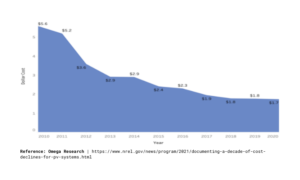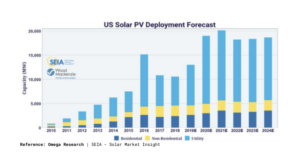- Industries
Industries
- Functions
Functions
- Insights
Insights
- Careers
Careers
- About Us
- Sustainability
- By Omega Team

The way we generate and use energy began a significant shift in the early 2000s, and has reached a tipping point in the United States where most new electricity production for the past few years has shifted to wind and solar from a historical coal and natural gas dominant industry. Before the 2000s, ratepayers have had little choice as to how and at what cost their energy was delivered to their building. As a result of cost reductions and increased solar deployments, the US has seen a tipping point in recent years that has allowed energy users significantly greater control over their energy costs and reliability. Simply put, companies that take a proactive approach to evaluate their energy strategy by including solar have cut costs and risks relative to their competitors. As cost reductions continue alongside ever greater options to finance solar projects, we will continue to see the adoption of solar energy expand both at the large utility-scale as well as a distributed generation where the end-use energy occurs. This article focuses on electricity production – solar photovoltaic (PV) panels. It will be those companies that take a proactive approach that will reap the greatest benefits.
Solar Synopsis
The sun is a natural reactor that releases energy, which is a source of abundant renewable fuel on Earth. The packets of energy, otherwise called photons travel through space and pierces the atmosphere of the earth to satisfy global energy needs. Approximately 173, 000 terawatts of solar energy are collected on the Earth at any given time. Solar energy harnesses a variety of sources, including but not limited to heating water for domestic, commercial usage, or generating electricity, providing light and comfortable interior environments. At its core, solar generates electricity using panels installed on a roof, parking lot canopy, or ground-mounted in fields or landfills. The energy produced is a direct current (DC), the same as what is produced by your car and is inverted from DC to alternating current (AC) which is what buildings and the utility grid use to generate energy.
Figure 1 & 2: EIA Annual Energy


There is a key policy that has driven solar adoption: net metering. Net metering allows a solar project to send excess energy their building doesn’t need back into the grid (more typical in the summer), and to pull energy from the grid at night and off-season times as is typical in the winter. For markets without net metering, colocating an energy storage system (battery) can make a clear business case for installing solar. Achieving cost savings has been a primary driver in solar adoption to date, though there has been an increasing desire by companies to build stakeholder confidence. Recent trends influencing company decisions include but are not limited to: Climate change, carbon and greenhouse gas emissions, environmental justice, the Paris Climate Accord, and ESG (Environmental, Social, Governance). Though incentives have been a primary driver of market penetration of solar, there is an increasing number of use cases due to the increasing cost of energy prices relative to the cost declines for solar. On the east and west coasts, with growing pockets particularly in Illinois. Apple, Amazon, Walmart, and Target are among the top companies with the most solar installed followed by a growing list of companies that aren’t just making targets and goals but executing on projects at an increasingly large scale. The Solar Energy Industries Association has developed a robust platform to help visualize where the 38,000 and growing amount of solar projects that have been installed by companies across the country. In addition, a large number of jobs have been created to support the growing sector that is helping drive the country’s economic recovery. There are well over 250,000 people currently employed by the solar industry. The Solar Jobs Census has found that there are 15 times more jobs in solar today than a decade ago.
Solar in Relation to Other Renewable Energy
Solar is a great tool in our box of energy and business solutions but is certainly not the only one. The most impactful solar projects are those that are part of a wider energy strategy. Starting with strategy development and followed by an energy audit, a multitude of energy control measures (ECMs) can be proposed and prioritized based on the companies’ specific criteria. For companies with facilities in multiple locations, particularly spanning different states and regions, having a strategy will ensure you are taking advantage of the multitude of changing incentives and regulations. Below is a list of the most common ECMs that are beneficial to consider alongside solar:
Building Control Systems: thermostats, boiler controls, IoT sensors & automation.
Energy Efficiency: LED lights, HVAC upgrades, UVC germ sanitizing lights/ventilation systems
Electric Vehicles (EV): When considering your fleet costs, EVs can reduce your cost and risk profile. EV chargers add a new load to your electric bill and can significantly impact demand costs if not managed properly.
Energy Storage & Backup Generators: Increased resilience and guaranteed savings by controlling how the solar energy is managed on the property.
Ultimately, there is no one size fits all solution for every company and building. While stand-alone solar projects have generated significant value to date, there are additional savings/returns that can be realized as a result of carrying out a proactive and integrated energy strategy. Another trend companies need to be aware of are the regular changes to electric rate tariffs by utilities. Increasingly, utility companies are shifting their rate tariffs to make solar less economical by charging more in the morning and evening when the sun doesn’t shine – further encouraging a solar plus other technology solution. Taking an integrated approach will ensure you don’t oversize your solar array depending on the amount of energy/kWh reductions available through efficiency measures; equally important if you are considering EVs for your fleet and/or chargers available at your facility it will drive up demand for electricity that can be provided by solar. Note Annual usage: 3600 kWh, $40/month in electricity cost. This equates to a need for a 3.5 kW solar array per charger assuming they are being used the majority of the workweek 8-5 pm.
Applications of Solar Energy for Companies
As corporations adapt to a hybrid office modality, reassessing cost-reduction implementations must be integrated for an effective transition. There is a multitude of reasons that have executives in all 50-states evaluating and installing solar. As corporations adapt to a hybrid office modality, reassessing cost-reduction implementations must be integrated for an effective transition. There is a multitude of reasons that have executives in all 50-states evaluating and installing solar.
Cash Flow Management: Without solar companies’ electric bills can vary significantly month to month tying up critical working capital for other company needs. There are a variety of financial vehicles to finance solar, ranging from a property assessment, included on your electric bill, or another off-books method with fixed monthly payments.
Tax Credits & Depreciation: The federal tax credit that was recently extended at the 26% level along with the ability to depreciate the project cost up to 100% in year one are the primary tax benefits discussed. Additionally, there are a number of state and local jurisdictions that offer additional tax credits that can increase the ROI/savings.
Generate Revenue With Demand Response Programs: In the ⅓ of the US that have open markets, companies can generate revenue by reducing their demand for electricity, and additional value for exporting power to the grid when it is most stressed, typically in the summer.
Some companies are getting their returns primarily from tax credits, while others that can’t efficiently consume the credits benefit from the guaranteed long-term savings. While the reasons companies are going solar can vary widely, those that elect to not evaluate solar in their energy strategy may be missing out on significant benefits.
Financial Analysis of Solar Energy
Given that every company has a unique set of resources, constraints, and goals, there is a multitude of ways that solar transaction types can cover the cost. Before we get into a summary of the options, it is important to consider when evaluating whether solar energy is the right fit for your company, understanding that solar is an avoided cost technology to offsets and in some cases eliminates your electricity expenses. Simply put: not making a decision to evaluate and/or implement solar won’t change your utility companies’ mind – if you need power from the utility, they will gladly continue to deliver and charge you for it.
Direct purchase: Typically best when the company has a federal tax liability that can efficiently use both the tax credit and depreciation.
Power Purchase Agreement (PPA): The PPA is one of the most common 3rd party finance options for going solar. They are typically a 20-year term with an initial cost that is generally less than current energy costs with a fixed annual escalator that typically ranges from 0%-3%.
Property Lease: Companies can lease property space (roof, parking lot for canopies, or a field) to host a solar project. Similar to generating revenue from a billboard or cell phone company, the solar company pays a lease fee while selling the electricity through various channels.
Commercial PV Cost Declines Since 2010
The graph illustrates the dollar cost per 100 MW from 2010-2020. The cost of solar electricity has decreased by over 60% over the past 10 years, making it significantly more accessible to families and businesses across the country.
Figure 3: Solar Electricity Decreased

The Future of Solar
There is no doubt that solar energy will continue its meteoric rise across the spectrum from residential, commercial & institutional, and utility-scale projects. The year-over-year cost declines we saw from 2000-2015 have slowed dramatically, though we anticipate annual cost declines to continue albeit at a much slower rate. The National Renewable Energy Laboratory has generated some helpful insights as to the cost declines and future of solar, particularly when coupled with energy storage.
Figure 4: SEIA – Solar Market Insight

Conclusion
Solar energy is a dynamic and increasingly large method of generating electricity ranging from the residential scale through commercial & industrial to utility-scale projects. The solar industry has evolved to provide more integrations with other energy control measures and is best deployed as a tool in the companies’ comprehensive energy strategy.
Subscribe
Select topics and stay current with our latest insights
- Functions